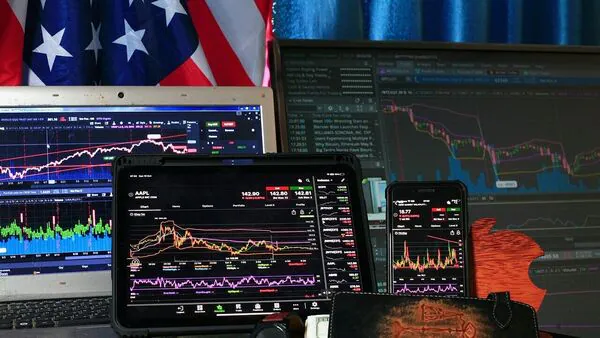
- Indices
- Stocks
Indexes rise on Powell’s remarks
Do you want to know how to make money from this?
Register for free and get expert advice, access to a training course and webinars.
Key points:
- US stock indexes including the Dow Jones, S&P 500 and Nasdaq posted significant gains after Powell’s comments.
- Powell confirmed that the central bank is considering cutting interest rates due to labor market risks.
- The Federal Reserve is now placing greater emphasis on protecting the labor market, especially as the US presidential election approaches.
Federal Reserve Chairman Jerome Powell’s dovish comments in Jackson Hole on Friday had a positive impact on U.S. stock indexes. Market participants interpreted his words as the central bank’s intention to ease monetary policy and lower the key rate. In response to these expectations, the Dow Jones Industrial Average, S&P 500 and Nasdaq Composite rose significantly.
The Dow Jones Industrial Average rose 462.3 points, or 1.14%, to 41,175.08. The S&P 500 rose 63.97 points, or 1.15%, to 5,634.61, and the Nasdaq Composite added 258.44 points, or 1.47%, to 17,877.79.
Indices show biggest weekly gain
Three key U.S. stock indexes rose significantly following Powell’s remarks at the symposium, with large caps like Nvidia, Apple and Tesla leading the way. Small-caps and regional banks also performed well, rising 3.2% and 4.9%, respectively.
The financial sector hit an all-time high, with regional banks especially strong. If there was a major disaster or recession on the horizon, regional banks and financial companies would not be as resilient, he said. All three indexes posted weekly gains, recording their biggest Friday-to-Friday percentage gains this year.
All 11 major S&P 500 sectors ended the session in positive territory, with real estate posting the biggest percentage gain, up 2.0%. Trading volume on U.S. exchanges was 10.57 billion shares, below the 11.88 billion shares average per session over the past 20 trading days.
Powell’s Jackson Hole speech gives traders hope
Federal Reserve Chairman Jerome Powell signaled Friday that the central bank will soon begin cutting interest rates, a move that comes amid concerns about the labor market cooling too much and confidence that inflation is creeping toward the 2% target.
Speaking at the annual Jackson Hole Economic Conference, Powell stressed the need to adjust monetary policy, but noted that the exact timing and pace of rate cuts will be determined by incoming economic data and the current situation.
This decisive turn away from a tough fight against inflation signals a new phase in the Federal Reserve’s activities. The central bank is now more focused on protecting the labor market, especially with a key US presidential election approaching.
Powell expressed confidence that inflation is on a steady path to decline, despite a significant increase during the COVID-19 pandemic. At the same time, he acknowledged that a slowdown in the labor market has become more likely and the risks of further employment losses have increased.
Given the current level of interest rates, the Federal Reserve has ample maneuvering to reduce borrowing costs and stimulate economic activity.
Do you want to know
How to make money from the news
Register for free and get:
- Expert consultation;
- Access to the training course;
- Opportunity to participate in webinars

